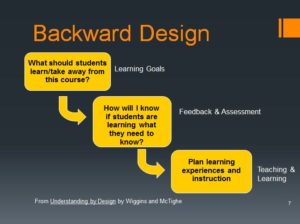gradstep recap: course design
this blog post is written by dan morrison, a cft graduate teaching fellow. dan led the course & syllabus design session at gradstep on january 21, 2012. you can download the powerpoint and handouts from this session.
“integrating learning goals, feedback & assessment, and teaching & learning activities for significant learning”
in this gradstep session, i covered the basics of l. dee fink’s approach to developing courses that are designed to maximize student learning by integrating course goals, feedback and teaching activities. fink is well known for his book creating significant learning experiences: an integrated approach to designing college courses.
i wanted workshop participants to walk away with two “enduring understandings”:
- significant learning experiences can be designed into the course. they rarely happen spontaneously.
- teaching is a dynamic process. because of this, designing effective learning experiences is both a process and an outcome.
we approached these understandings by focusing on designing the overall structure of the course. beyond a list of content, we reflected on how the pieces fit together to create a coherent whole. often, courses tell a story, they have a “narrative arc” that is sometimes chronological (e.g. american history from 1865 to present) or from micro-biology (e.g. cells) to macro (e.g. mammals). the best courses pose questions and raise topics that build in complexity and conceptual rigor as the course advances. many exemplary courses ask students to develop content knowledge, learning and research skills, and changes in affect, such as dispositions and passions.
participants worked individually, and in groups, to identify situational factors that enable and constrain their courses. we considered the context of the course, the general institutional context, the nature of the subject, characteristics of the learners and characteristics of the teachers.
 given these factors, we used backward design to create
given these factors, we used backward design to create
“what would i like the impact of this course to be on students 2-3 years from now?” learning goals. in order to help, i asked everyone to focus on these questions:
- “what would distinguish students who have taken this course from those who have not?”
by asking these questions, we tap into the rich, deep learning goals that we have for students: about critical thinking, creative use of knowledge from the course, learning to solve real-world problems, and changing the way students think about themselves and others. answering these big questions helps us avoid vague goals that focus on memorizing content and simply repeating it for exams. many of us want our students to develop the highest levels of thinking, research and critical skills.
with these in mind, i asked the group to think about how they would know their students are meeting these goals. this is the feedback and assessment piece. one way to do this is to give students exercises, questions, or problems that create a real-life context for course material. doing so is called “forward-looking assessment.”
next, we discussed teaching and learning activities, with a focus on active learning. to create deep learning for our students, we need to go beyond discussion and lecture to engage students in experiential learning and opportunities for reflective dialogue about their learning. active learning, then, helps students understand their own learning process better, a skill called metacognition. metacognition is important because it can help motivate students to engage in the course more actively, and study more efficiently. dr. chew at samford university has an excellent series of videos on metacognition.
here are some ideas for active learning:
in class: debates, simulations, guided design, small group problem solving, and case studies.
out of class: service learning, situational observations, and authentic projects.
finally, i asked everyone to check their work. integration is the final step in the course design process. learning goals, feedback and assessments, and teaching and learning activities must all be tightly coupled. it is okay to share the details of your design with students—let them know what the “story” of your class is! understanding how the parts relate to the whole is a key part of metacognition, and the way experts (you) relate to your discipline. often, students need help putting everything together. by integrating your course, your teaching and learning activities will prepare students for their exams, projects, case studies and simulations. together, they will ensure that you are meeting your learning goals.
in an upcoming blog post, dan will continue his discussion of course & syllabus design as he describes the portion of the gradstep session focusing on syllabus construction.

leave a response